Abstract
This research investigates the play behaviour and activity patterns in terms of movement and the amount of time spent on various play equipment across five diverse playgrounds in Budapest in different contexts: Citypark Playground, Normafa Playground, Péter Zöld Playground, Benczúr Playground, and Gellérthegy Slide Playground. Employing observational methods, we recorded data on movement/activity types, time allocation, and equipment usage among different play equipment to evaluate how children interact with these various play structures and the average time spent on each. Across these playgrounds, we conducted an analysis of over 400 individual interactions and behaviours among children aged between 1 and 14 years old. Activities were categorised into primary movements, including climbing, sliding, swinging, and balancing, and secondary movements, encompassing actions such as jumping, sitting, bending, hanging, crawling, and others. On average, children spent between 5 and 10 min on popular equipment like ziplines and carousels, while static structures, such as wooden piles and bridge climbers, showed consistent but less dynamic usage. Key findings revealed that complex play designs and dynamic structures attracted the highest levels of engagement, encouraging a broader range of movement types. For example, ziplines and complex equipment accounted for 27% of total observed activity, emphasising their role in promoting physical activity and excitement. Time spent on different equipment types varied significantly across these playgrounds, influenced by design complexity, spatial density, and environmental factors. These insights emphasise the importance of well-considered playground design in fostering physical activity, creativity, and social interaction among children. The study’s implications extend to urban planners, architects, designers, and decision-makers, offering recommendations for creating more inclusive, engaging, and developmentally appropriate play spaces that foster a diverse range of abilities and preferences.
1. Introduction and Relevance
While playgrounds are settings primarily designed for children under age 12, they have the potential to help people of all ages to be physically active and engage in diverse movements (e.g., climbing, swinging, jumping, and spinning) to meet both aerobic physical activity guidelines and engage in recommended muscle and bone strengthening activities [1,2]. Because physical activity is higher when people are outdoors than indoors [2,3,4,5], capitalising on factors that increase the time spent outdoors may be a promising way to support more physical activity as well as enhance mental health, which has been associated with time spent in nature [2,6]. Playgrounds are settings designed for children to be physically active, yet there has been little research assessing which play elements and structures are associated with more moderate-to-vigorous physical activity among both youth and adults [7]. Despite the lack of consensus on how play is defined, it is understood to involve activities that are freely chosen, child-led, opportunistic, fun, and can be experienced independently as well as with others [8]. Wan Hee Kim (2018) described the importance of outdoor playing in the city and demonstrated that children are the primary agents of urban play [9].
The development of foundational movement skills is crucial for promoting physical activity across the lifespan. A conceptual model proposed by Hulteen et al. emphasised the importance of these skills, which encompass a broader range of movements than traditional fundamental movement skills. This model suggests that competency in foundational movement skills can facilitate lifelong engagement in physical activities, influenced by various factors, including culture, physical attributes, and psychological aspects [10,11]. Foundational movement skills include both traditional skills (e.g., kicking and jumping) and more complex movements (e.g., swimming and cycling) that support diverse physical activities throughout life [10]. During childhood and adolescence, regular physical activity (PA) is associated with improvements in both physiological and psychological health [12]. Play contributes to the physical, intellectual, emotional, and social development of all children [13]. The natural environment or an environment with predominance of natural elements can influence not only the physical but also the psychological state of a person as a positive factor in the creation of spaces [14]. Playground PA varies by the physical environment, including equipment provision, and activity type. While these factors have been identified as potential influences of children’s PA during recess, few studies have systematically observed PA across multiple ages and playground features. For instance, fixed equipment and markings have been investigated in children and adolescents, and the association with PA was inconclusive [15,16]. In comparison, unfixed equipment (e.g., balls and skipping ropes) has been investigated only in children, with positive associations found [15,16]. PA does not only strengthen physiological health but has also been associated with a range of cognitive and psychological factors, such as creativity, memory, problem-solving, and language development (Drollette and Hillman, 2020; Kahan, 2008) [17].
In city settings, urban playgrounds play an important role in socialisation, recreation, and childhood development within urban landscapes and neighbourhoods within the communities. As cities grow and evolve, the design and sustainability of these playgrounds become increasingly important factors to consider. In today’s world, building spaces for our children to play is not just about fun—it is about the future [18]. Outdoor play is universally recognised as a vital element in healthy physical and emotional development in children. The benefits to a child’s physical development have long been recognised and are derived from increased activity levels and use of energy, growth and strengthening of large muscle groups through movements such as climbing, running, swinging, and jumping, plus an increase in cardiovascular endurance, and large and fine motor skills [19]. Children’s movements are highly complex, and thus require measurements that capture various gross motor strategies [20]. The literature indicates that playgrounds can play an important role in challenging children’s balance, agility, and coordination. However, knowledge on the influence of playgrounds on children’s fundamental movement skills’ development is fragmented [11].
Urban playgrounds serve as important spaces for socialisation, recreation, and child development within communities, making their design and sustainability increasingly important considerations. The quality of the built environment can promote health and well-being by exposing our brain to the right balance of stimuli in a way that creates positive emotions and experiences [21]. Designing playgrounds with a focus on sustainability is crucial for fostering a healthy and resilient environment for both children and the planet. Eco-friendly playground design, also known as sustainable playground design, focuses on creating play spaces that are environmentally conscious and promote a greener future [22].
While previous studies have identified various factors influencing children’s physical activity in playgrounds, there remains a need for more systematic observation across multiple age groups and diverse playground features. Furthermore, the specific play elements and structures that promote moderate-to-vigorous physical activity require further investigation, as does the understanding of how playground design can foster long-term engagement and sustainable play environments, and how children engage with play equipment and structures differently.
This research examines different play behaviours and activity patterns among children, focusing on their movement and time spent using various play equipment and structures across five distinct playgrounds in Budapest, each within unique contextual settings, varying between urban environments, hilly terrains, natural landscapes, and local residential areas. By understanding how children interact with diverse play structures and equipment in these varying contexts, the study provides critical insights into the factors that drive children’s engagement within play settings, their movement diversity, and equipment preferences. Understanding these behavioural patterns is crucial for identifying play elements that can promote long-term physical activity, inclusivity, creativity, and health among children, while also addressing their developmental needs in alignment with environmental and social sustainability. The main goal of this research is to provide valuable guidance for playground designers and planners in recognising children’s preferences and in promoting a varied and stimulating range of play opportunities among all ages.
This research aims to fill the gaps by examining play behaviour and activity patterns across five diverse playgrounds in Budapest, focusing on the relationship between equipment complexity, movement types, time allocation, and children’s engagement. By analysing how children interact with various play structures in different contexts, this study provides valuable insights for designing more inclusive, engaging, and sustainable play spaces. This study explores the relationship between playground equipment design and children’s play behaviour, focusing on the levels of engagement, time allocation, physical activity patterns, and type of actions. By analysing data on the usage of various play structures across multiple playgrounds in different settings, this research aims to identify how equipment complexity, movement types, and design features influence children’s interactions and play duration.
The research questions include:
- How does the complexity of playground equipment influence its popularity, level of engagement, and duration of use among children?
- How do different types of play equipment facilitate varying levels of physical activity and movement among children?
- How can play behaviour, activity patterns, and playground design contribute to the development of a sustainable play environment?
2. Literature Review
The integration of sustainability aspects into playground design is highly essential, drawing on theoretical frameworks from landscape architecture, urban health, and ecological design to establish a foundation for more resilient and inclusive urban play environments. From a landscape architecture perspective, Elizabeth Calabrese highlighted the importance of biophilic designs. In her book, The Practice of Biophilic Design [23], she addressed the importance of this biophilic design approach and it how focuses on human adaptations to the natural world that, over evolutionary time, have advanced people’s health, fitness, and well-being. It also promotes positive interactions between people and nature that encourage an expanded sense of relationship and responsibility for the human and natural communities. Similarly, discussing therapeutic landscape theories, Roger S. Ulrich, in his article “View Through a Window May Influence Recovery from Surgery” [24], highlighted the importance of therapeutic designs. His findings showed that 23 surgical patients assigned to rooms with windows looking out on a natural scene had shorter postoperative hospital stays, received fewer negative evaluative comments in nurses’ notes, and took fewer potent analgesics than 23 matched patients in similar rooms with windows facing a brick building wall. This addresses the importance of the therapeutic approach and how playgrounds can play a significant role in terms of supporting development, health, and emotional needs.
Magdalena Czalczynska-Podolska, in her article [25], addressed the need for a change in the approach to playground design towards creating spaces with therapeutic qualities that are fully inclusive and, therefore, meet the principles of sustainable design. She also added that it is necessary to implement an integrated approach, based on the implementation of the identified components of therapeutics and three paths to the implementation of a therapeutic playground. This can contribute to improving not only the quality of playgrounds but also public spaces in cities and realising the idea of a city that is friendly to all residents.
In addition, James F. Sallis emphasised the importance of urban health through his article “Role of Built Environments in Physical Activity, Obesity, and Cardiovascular Disease”. The purposes of the present report are to describe multilevel ecological models of behaviour as they apply to physical activity, describe key concepts, summarise evidence on the relation of built environment attributes to physical activity and obesity, and provide recommendations for built environment changes that could increase physical activity [26]. Ecological models specify multiple levels of influence on behaviour, from individual and social factors to institutional, community, built environment, and policy factors. A key principle is that interventions should be most effective when they change the person, the social environment, and built environments and policies [26].
Current Australian legislation promotes playground inclusion for all children, and playgrounds serve as local, safe, and vital spaces for children of all ages to play [27]. Thus, it is very crucial to consider inclusivity in the design process to promote social sustainability and an inclusive urban environment.
Reference [19] examines how material choices and shading can mitigate urban heat island effects and enhance playground usability. Selection of an appropriate material type and colour tone, together with the provision of shade, can remove the hazard risk for contact skin burns from outdoor playgrounds. Results of this work will assist playground designers and managers to provide safer places for our children to play longer in increasingly warmer summers [19]. Therefore, material selection plays a critical role in sustainable playground design, for instance, permeable surfaces and shade structures can reduce heat retention and extend playtime in urban settings.
By integrating these frameworks, future playgrounds can better balance ecological resilience, health promotion, and social inclusivity. This study focuses on the nature and levels of interactions between children and play environments, emphasising the degree of engagement and how they interact within these settings. Analysing how children use these spaces not only sheds light on their social dynamics but also supports social sustainability. Furthermore, as previous research and literature have shown, increased physical activity—fostered by engaging play environments—contributes to both improved health outcomes and the creation of more resilient public spaces.
3. Methodology
This study employed a mixed-methods observational approach to evaluate children’s interaction patterns with the different playground equipment and structures across the selected five playgrounds. The methodology comprised three primary phases: site selection, data collection, and analysis.
3.1. Site Selection
The playgrounds were selected based on their different contextual settings, diversity in equipment design, and accessibility. Each playground featured a mix of static (e.g., swings, sandbox, sculptures, seesaw, etc.) and dynamic (e.g., ziplines and carousels) equipment to ensure variability in interaction and movement types. Additionally, playgrounds were chosen to represent different urban settings, ranging from residential locations to more urban areas. Figure 1 represents the different settings the playgrounds are located in (natural, touristic, recreational, and residential neighbourhood).
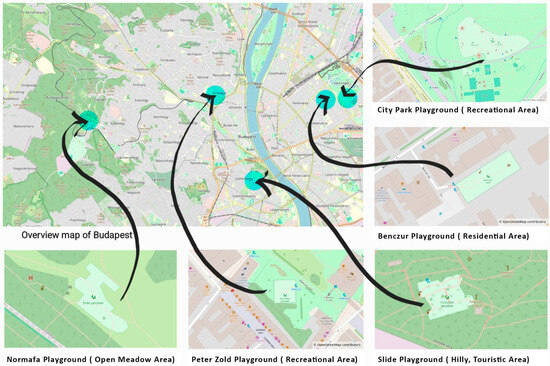
Figure 1.
Playgrounds’ locations in different contextual settings in Budapest. Sources: https://www.openstreetmap.org (accessed on 2 May 2025).
The five playgrounds selected for this study in Budapest represent a diverse range of contexts, each holding unique features and representing different spatial play experiences.
The first, Citypark Playground (Nagyjátszótér of Városliget), is situated in the heart of Budapest within the renowned Városliget park, a popular recreational space and cultural hub located in the pest side of Budapest. This playground is characterised by a variety of play zones and equipment, including large, complex play structures, an interactive water play area with various features, and multiple swing and climbing options designed for both individual and group play. Notably, the playground also accommodates family engagement, with parents frequently participating in activities alongside their children, such as complex swings where parents are using them too. A prominent feature of the design is a large, balloon-like structure that serves as both a climbing element and a viewpoint, becoming a central focal point of the playground.
The second playground, Gellérthegyi Slide Playground (Slide Park of Gellérthegy), is located in a hilly area on the Buda side of the city, within the Szent Gellért square touristic area. The playground’s design emphasises dynamic, physically engaging play through its distinctive slides and climbing wall and a viewpoint play structure, providing an exciting experience for children.
Benczúr Playground (Benczúr-garden Playground), situated in a residential area, offers a more intimate and localised experience for the community. This playground incorporates a variety of play structures, including animal-shaped and architectural designs, creating a thematic, colourful, rich, and narrative-driven environment that encourages imaginative play.
The fourth playground, Péter Zöld Playground (Péter Zöld Fairytale Playground), located in Millenáris Park, is smaller in scale but still offers diverse play experiences. Despite its compact size, it effectively integrates various play elements that cater to the developmental needs of children. The story is outlined on the toys, so the kids can explore the individual elements following the thread of the tale, but the playground is also a real pleasure if the children just slide, climb, and jump carefree [28].
Lastly, Normafa Playground (Playground of Anna-rét, Normafa), located about an hour from Budapest’s city centre, is set in a large, open meadow area. The playground elements are strategically placed within the natural landscape, emphasising the connection between play and outdoor exploration.
These playgrounds collectively demonstrate the wide-ranging design approaches in Budapest, catering to different environments, cultural contexts, and user experiences.
Figure 2 displays photographic examples of the various landscape contexts observed across different zones and areas within each of the five studied backgrounds examined in this study.
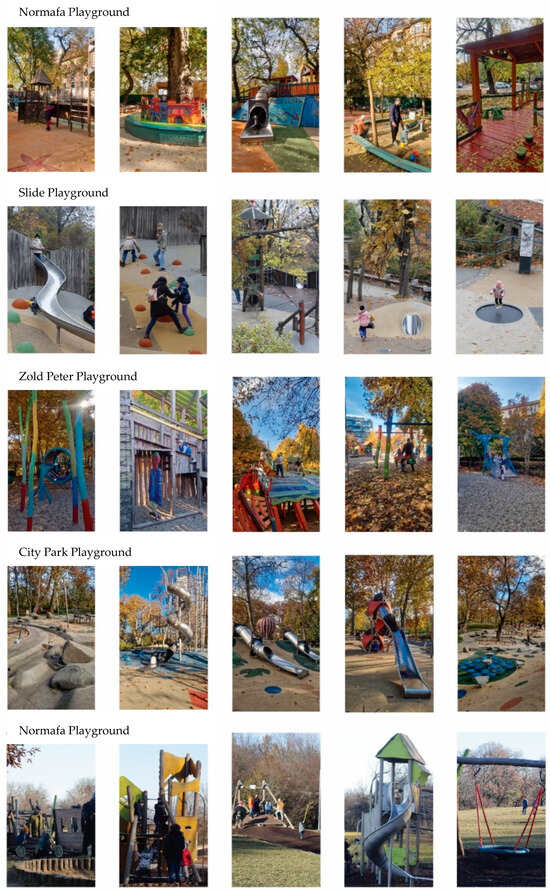
Figure 2.
Photos of the five examined playgrounds in Budapest.
3.2. Data Collection
- Sample SizeA total of over 400 children, aged 1–14 years, were observed across all playgrounds’ sites.
- Observation FrameworkData were collected through on-site observations during peak hours (10 a.m.–3 p.m.) over a two-month period in Autumn between October and November 2023.
Observations recorded included movements, time spent, and behavioural sketches. Movements referred to the types of physical activity (e.g., climbing, sliding, balancing, jumping, hanging, etc.). These movements were classified based on the body regions engaged: whole body (e.g., climbing and balancing), mostly lower body (e.g., sliding and jumping), lower body, and upper body. Additional categorisations captured activities involving the whole body, with emphasis on either the lower or upper body. This comprehensive classification framework provided a detailed understanding of the types and intensities of physical activity observed during playground interactions. Time spent was measured by recording the duration of activity for each piece of equipment or structure in seconds using a stopwatch. Behavioural sketches involved visual documentation of children’s movements, interactions, and behavioural patterns in relation to the play equipment and structures.
- Tools UsedObservers used standardised recording sheets and timing devices, sketchbooks, and later Microsoft Excel and SPSS. Verbs describing movements (e.g., jumping, swinging, and sliding) were pre-categorised for consistent coding.
3.3. Data Analysis
Quantitative observations were translated into numerical data to better understand how the playgrounds were used. For each piece of equipment, children’s durations of stay were measured, as well as how often they chose to play on each play equipment. This gave a clear, balanced picture of which areas were the most popular and how active each space was across the playgrounds. Field narrative notes were documented through qualitative analysis, which focused on the character of play rather than the duration. Each interaction was categorised based on the type of social engagement—collaborative or cooperative play, solo engagement, or inclusive group activity—and for play type, such as functional, symbolic, or constructive. These narrative codes reflect how children interpreted each play setting and interacted with one another. The quantitative metrics and qualitative codes were then examined through a comparative analysis across all five playgrounds. Data were compared across playgrounds to identify trends and differences based on design elements, such as equipment diversity and the level of engagement between the children and the play equipment. The study assigned the target age groups to the play equipment everywhere, in order to get adequate feedback on possible matches and differences between the different age groups. Additionally, the maximum and average number of users for each piece of play equipment was recorded.
Physical activities and social interactions are important in children’s life experiences and their development. To facilitate these experiences, places are required to promote outdoor activities for children [29]. It is important to also understand how different types of outdoor play opportunities and environments can impact children’s holistic development and learning, so that children’s wider development can best be supported through decisions related to practice, policies, and funding [30].
According to [2], to increase population-level physical activity and time spent outdoors, playground features associated with a longer stay should be considered when renovating or building new playgrounds. Playground characteristics that attract more users and are associated with more moderate-to-vigorous physical activity, such as the design, size, and number of unique features, should be integrated into future playground designs and renovations, with innovative designs prioritised for low-income neighbourhoods [31]. There is a valid relationship between playground equipment and children’s fundamental movement skills. Some of the fundamental movement skills are already supported by existing equipment, and the remaining fundamental movement skills can be implemented in future or existing playgrounds [32]. As concluded in [24], designers should not only increase the variety of play styles by improving natural elements but also focus on how to make playgrounds more playable and how to encourage children to play and enjoy themselves from children’s perspectives.
4. Analysis
4.1. Observational Analysis
The five playgrounds—Citypark, Gellérthegy Slide, Normafa, Péter Zöld, and Benczúr—each feature distinct play equipment and structures that influence how children generally interact with them. Ziplines, complex equipment, swings, and slides are the most engaging, with children spending extended time running, climbing, and sliding. Thematic elements like climbing walls, tunnels, and dollhouses encourage exploration, hiding, and role-playing, while static toys and gates experience minimal use in terms of the interaction between children and those play features. Social dynamics vary among those play structures, with group play taking place around multi-functional equipment and quieter activities, like sitting or hiding, occurring near benches, sheltered spots, or corners. Parents often observe or socialise but occasionally join in on swings and seesaws with their children. These interaction patterns are visually summarized in Figure 3.
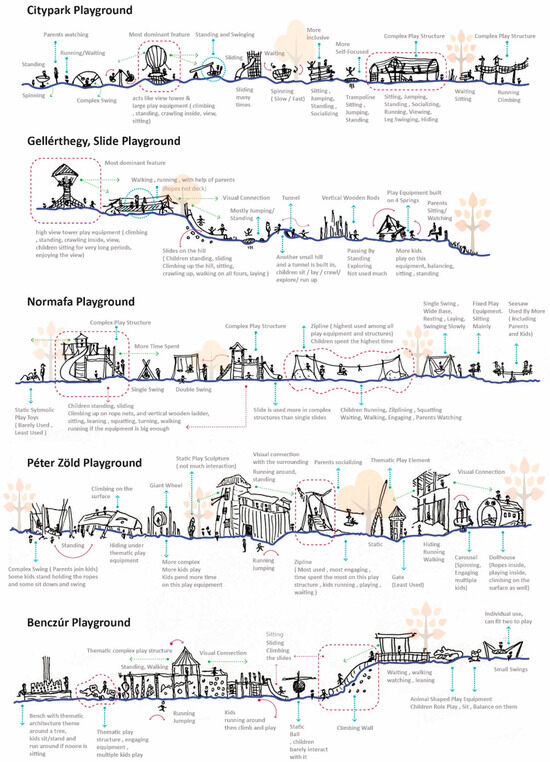
Figure 3.
Visual sketches illustrating the children’s play movements and behaviours across the five playgrounds.
Key features show that dynamic, inclusive designs—such as hills with tunnels, towers with views, and equipment supporting various play styles—foster longer stay engagement. While high-energy activities dominate, quieter areas for rest and socialising are used as well. The least popular features are those with limited interactivity, emphasising the importance of hands-on, adaptable play structures in order to build more successful playground designs.
4.2. Quantitative Analysis
Among the children using play equipment, 10 children’s time per play equipment was documented, which became the average time spent on the play equipment.
The calculated time was recorded using a stopwatch to precisely measure how many seconds children spent on each piece of play equipment and structures. For each playground, the time spent by randomly selected children, with a sample size of 10 children per piece of equipment, was measured, resulting in a total of 680 individual time entries among the 68 play structures surveyed. While some children used more than one piece of equipment, the dataset represents observations from approximately 400 different children. After data collection, the average duration of use (in seconds) was calculated for each play element, resulting in providing more accurate datasets than minutes.
Examples of time spent per play equipment are shown in Figure 4.
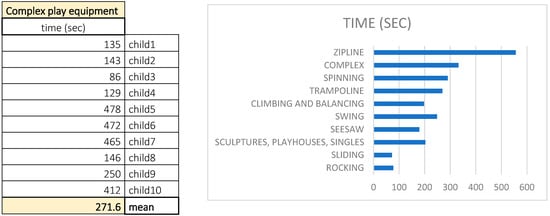
Figure 4.
Visual representation of the time allocation across various play equipment.
The verb list was derived from a variety of physical activities and movements while engaging with the different play equipment and structures, including running, leg swinging, jumping, sitting, sliding, squatting, pulse squatting, walking, leaping, kneeling, stamping, bending, arm swinging, holding, trodding, pulling, flexing, head circling, clapping, jogging, pushing, pressing, climbing, scratching, stretching out, digging, reeling, balancing, stopping, hitting, twisting, turning, crawling, body circling, knocking, leaning on, dodging, rolling, spinning, backstretch, walking on all fours, and lying.
These types of actions represent a broad range of daily movements, encompassing both dynamic and static motions. During the data analysis, all the movement verbs recorded for each play equipment in the field survey were narrowed down to the list of the most common movement verbs (movement frequency verbs). The most common movement verbs described the movements that almost always occurred while using the play equipment, so these verb numbers represent the certainty.
The most common movement verbs have been grouped according to their intensity: light (LI), moderate (MI), and vigorous intensity (VI). The type of movement intensity of the play equipment was determined by the maximum number of the most common movement verbs belonging to the listed groups. The equipment associated with these activities had different ranges of these verb lists, and the ones that featured the most actions were ranked the highest in the categorisation system, demonstrating their diversity and comprehensive utility in facilitating various physical activities.
In order to distinguish between the different intensity movement verbs assigned to the play equipment, an evaluation system was needed. The evaluation system can help to draw conclusions not only based on the number of movement verbs, but also to discover significant differences between the intensity of the verbs, while at the same time the verb groups and verb sets formed by the verbs can also be easily evaluated, compared and ranked.
Movement intensity can be divided into three types: light, moderate, and vigorous. All three types may be repeated during the examination of a play equipment, so there may be several movement verbs that represent, for example, light intensity (walking, sitting, sliding, etc.).
Considering that one of the main pillars of the research was the examination and evaluation of movement, the goal was to create a high-resolution ranking with only three values (as long as repetition was allowed), thereby creating high variance and clear differentiation.
Two aspects (movement intensity and time) were selected as primary scoring systems for the evaluation. The movement intensity was scored as follows: 1 point, 10 points, and 20 points, which clearly defined a ranking system that could be influenced by, but not distorted by, secondary scoring systems (number of movement frequency verbs, value of interest, and popularity value).
Due to the measurability of intensity, verbs with different degrees of movement intensity received different scores which are represented in the following figure (Figure 5).
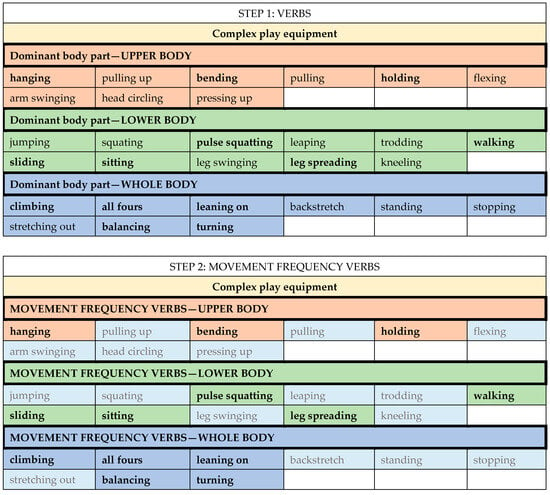

Figure 5.
Representation of the movement analyses.
A regression diagnostic model was applied to explain the number of the most common movement verbs (number of movement frequency verbs) as an independent value of linear regression, and to explain the value of movement intensity as a dependent variable.
During the condition test, the normality test for the error terms was acceptable based on the Kolmogorov–Smirnov (K-S) test.
The regression model was calculated as follows:
where beta0 (b0) is the intercept of the regression model, beta1 (b1) is the slope of the regression model, and the error is referring to the residual/error. The independency of the residuals formed a relatively irregular cloud as a function of x (the number of movement frequency verbs) as illustrated in Figure 6.
movement intensity = beta0 + beta1 × number of movement frequency verbs + error
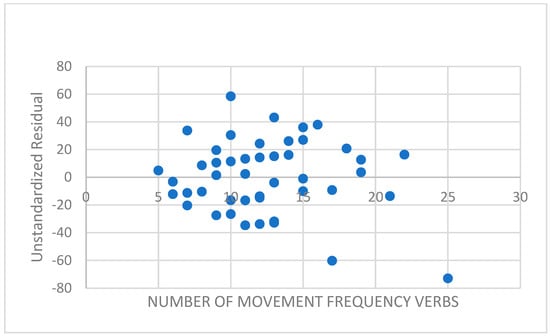
Figure 6.
Independency of the residuals.
As an estimate of the model parameters, the equation of the fitting function is:
movement intensity = −18.32 + 9.09 × number of movement frequency verbs
The regression diagnostics results are shown in Figure 7, which were obtained through these steps:
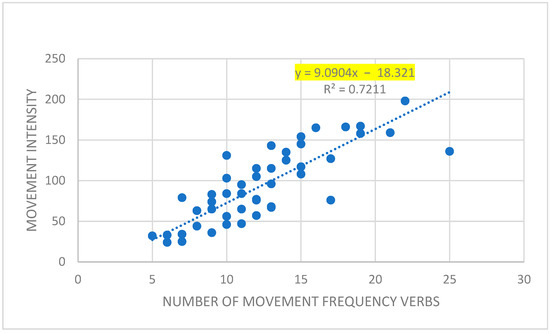
Figure 7.
Scatter plot of the number of movement frequency verbs and movement intensity.
- R2 estimation and significance → the linear relationship between movement intensity and the number of main movement verbs was significant (R2 = 0.721; p < 0.001).
- F-test (ANOVA) → the model was significant (F(1;68) = 170.62, p < 0.001).
- t-test for examining each parameter individually → testing the parameters of the model: the intercept and the slope estimate were also significant:
(intercept: t(68) = −2.03; p < 0.001; slope: t(68) = 13.06; p < 0.05)
The analysis was performed with the IBM SPSS Statistics 29.0.1.0 program.
The model showed that there was a linear relationship between the number of the most frequent movement verbs and the value of movement intensity. It can, therefore, be said that the more frequent movement verbs the play equipment in the five playgrounds require, the more likely it is that children will produce a higher movement intensity while using it.
The table below (Table 1) also supports the correlation, as it can be seen that play equipment generating low movement intensity had the least frequent movement verbs on average. Where “moderate movement intensity” movement verbs also appeared or dominated, a higher average quantity was observed. It can clearly be observed in the case of play equipment that lists the most frequent movement verbs on average that “vigorous intensity” movement verbs were also included in their verb list.

Table 1.
Intensity of movement based on the average number of MFVs.
4.3. Qualitative Analysis
Selected playgrounds were visited in person, and every piece of play equipment, including different play structures, complex play sets, and individual play components, was recorded. Children interacted with play equipment in several ways, ranging from functional, cooperative, and inclusive to self-focused and symbolic. The categorisations likely represent how children interacted with the equipment from different age groups, including:
- F (Functional): using the equipment as intended (e.g., swinging on a swing),
- C (Cooperative): playing with others (e.g., sharing a seesaw),
- I (Inclusive): allowing everyone to participate,
- CN (Constructive): building or creating something (e.g., building sandcastles),
- SF (Self-Focused): engaging in individual play (e.g., playing on a swing),
- S (Symbolic): using the equipment to represent something symbolic.
4.4. Comparative Analysis
It is necessary to observe what makes a play device interesting or not interesting for a child. To understand play device interest for children, field surveys demonstrated that equipment with high, moving, or fast-moving elements was more engaging. These elements were scored based on children’s preferences (Figure 8), enabling identification of the most preferred features and equipment for the children.

Figure 8.
Representation of the interest value analyses.
Based on the popularity ranking established during the on-site survey, we classified the play equipment into six categories for each playground according to their popularity: least popular, not very popular, slightly popular, moderately popular, popular, and most popular, which were assigned scores (Table 2).

Table 2.
Popularity classification and assigned values.
When creating the scores, two things had to be considered:
- As a secondary scoring system, it will influence the final ranking but not distort it.
- It will generate a clearly visible difference between the categories.
A regression diagnostic model was applied to explain the value of interest as an independent value of linear regression, and to explain the popularity value as a dependent variable.
During the condition test, the normality test for the error terms was acceptable based on the Kolmogorov–Smirnov (K-S) test.
The independency of the residuals formed a kind of irregular cloud as a function of x (value of interest) as shown in the following figure (Figure 9).

Figure 9.
Independency of the residuals (values of interest).
As an estimate of the model parameters, the equation of the fitting function is:
popularity value = −5.58 + 0.74 × value of interest
The regression diagnostics results are shown in Figure 10, which were obtained through these steps:
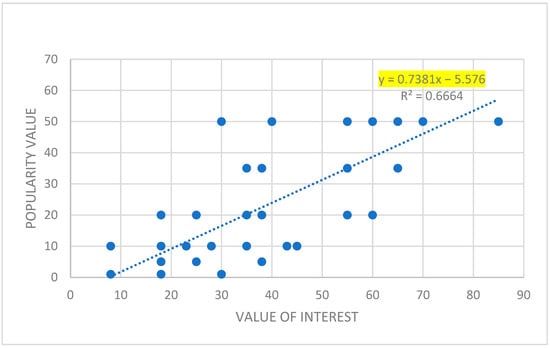
Figure 10.
Scatter plot of the value of interest vs. the popularity value.
- R2 estimation and significance → the linear relationship between movement intensity and the number of main movement verbs was significant (R2 = 0.666; p < 0.001).
- F-test (ANOVA) → the model was significant (F(1;68) = 131.88, p < 0.001).
- t-test for examining each parameter individually → testing the parameters of the model: the intercept and the slope estimate were also significant:
(intercept: t(68) = −2.13; p < 0.05; slope: t(68) = 13.06; p < 0.001)
The analysis was performed with the IBM SPSS Statistics 29.0.1.0 program.
The results were not as conclusive as with the movement test. As human behaviour is often unpredictable and influenced by numerous factors, achieving high R-squared values is challenging. In such cases, even relatively lower R-squared values, such as 0.50 or above, could be considered acceptable. The connection was clear; however, in order to determine popularity more precisely, several aspects must be taken into account due to the complexity of human behaviour. The scatter plot showed an acceptable result that the more interesting parts play equipment has, the more likely it is to be popular (have a higher popularity value).
Each observation was rated, and the results highlighted the “most used” pieces of equipment, providing insights into their design features, use, and their engagement levels. This analysis offers a valuable perception of play behaviours and equipment effectiveness across diverse playground settings.
The table below (Table 3) shows the data we recorded on the playground equipment found in the selected playgrounds (white background) based on the field survey, as well as the additional values recorded and obtained during the data analysis (light blue background).

Table 3.
Analysis of the five playgrounds’ equipment: presentation of all the analysed play equipment.
Interpretation of the age group designation in the large summary table is shown in Table 4.

Table 4.
Analysis of the five playgrounds’ equipment: presentation of all the analysed play equipment in terms of age groups.
The figure illustrates two main parts. The white background, where we recorded the names and types of the playground equipment, determined the play type they belong to, and indicated the target age group. We observed the average number of users on site, but we also noted the maximum number of users based on the size and complexity of the equipment. By observing the children’s movements, we recorded the verbs that appeared when using the playground equipment, highlighting the movement verbs that occurred with the highest frequency. We established a ranking of the playground equipment (separately for each playground), which showed what were the most popular (the lowest number) and what were the least popular (the highest number). The other part was the blue background, where we observed which body part the children used when performing each movement, so a body part name was added to each verb. The process was also presented during the data analysis phase of the body parts belonging to the most common movement verbs, the body part that participated in the most movements was highlighted previously as the dominant body part. The definition of movement intensity and its values were also performed during the analysis, which was illustrated earlier, supplemented with a textual explanation. For each play equipment, we indicated how many seconds passed on average during their use, which was precisely determined and derived during the analysis process. The values related to popularity and levels of interest were also indicated, which were also presented previously.
5. Results
The following bar chart provides a comprehensive summary of the analyses conducted throughout this research, including all surveyed playground equipment. The evaluation considered key factors contributing to sufficient and meaningful movement experience, which included a varied and intense range of movements that were characterised by numerous movement verb lists and dynamic actions, alongside the attractiveness of the play equipment, as defined by its popularity and interest value. Additionally, the time spent engaging with each piece of play equipment was considered in the assessment. To enhance clarity, the diagram systematically integrated the most common movement verb lists, movement intensity values, popularity scores, interest levels, and time spent on each equipment type, offering a holistic representation of children’s physical engagement in different playgrounds’ contexts.
The equipment was categorised into six ranked categories based on time spent, verb lists (jumping, climbing, sliding, sitting, bending, etc.), and popularity among children. The hierarchical categorisation of playground equipment, derived from an analysis of children’s engagement time, associated verb usage, overall popularity, and their levels of engagement with the various equipment, represents a general understanding of children’s play preferences. The highest rank emphasised equipment that fosters high levels of physical activity and engagement, such as ziplines, complex play structures, climbing walls, and spinning equipment. Subsequent ranks demonstrated a gradual decrease in physical activity, encompassing swings, trampolines, unique seesaws, and smaller-scale play elements, like small swings and carousels. Further down, the ranking included balancing equipment, slides, and generation swings, followed by static elements like wooden piles and spring toys. The final rank was represented by imaginative and creative play, such as play sculptures and dollhouses. This comprehensive framework offers valuable insights for playground designers and decision-makers to create inclusive and stimulating play environments that foster diverse play needs and interests of children.
These findings can guide designers, architects, urban planners, and policymakers in designing playgrounds that support various movement and engagement opportunities, which can respond to diverse contextual landscape settings. Well-designed playgrounds not only encourage more active and inclusive play environments but also contribute to creating resilient environments that foster sustainable long-term community use and well-being.
As demonstrated and discussed previously, in the following figure (Figure 11), equipment such as ziplines and complex play structures (e.g., climbing walls with slides) consistently ranked highest in both physical intensity and duration of use (averaging 657–728 s). These play structures facilitated vigorous, whole-body movements (e.g., climbing and leaping) and sustained social interaction, accounting for 27% of observed activity. In contrast, static or symbolic elements (e.g., rubber balls, spring toys, and gate sculptures) scored the lowest, with limited verb diversity (e.g., sitting, bending, and standing) and shorter engagement times (under 30 s). The values were taken into consideration when creating the final ranking of playground equipment: number of most frequent movement verbs + measured time + movement intensity value + value of interest + popularity value.
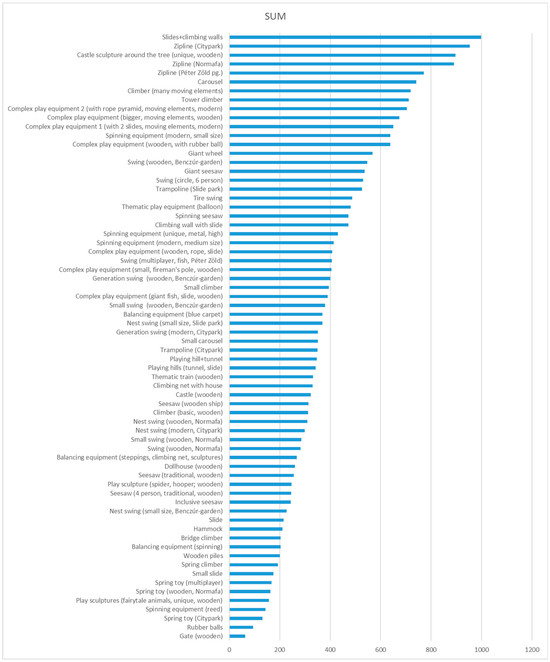
Figure 11.
Summary of the five playgrounds’ equipment use intensity and preference.
Categorisation of Play Equipment Based on Engagement and Complexity
Our research aimed to systematically categorise play equipment levels of engagement based on multiple criteria, including time ranking, verb list ranking, and popularity among children. Through the observational and numerical analyses of these aspects, we identified six distinct categories of play equipment and their engagement levels among children. Each category was characterised by specific features, complexity, and usability patterns for different age groups. The results of this categorisation are presented below.
Figure 12 categorises those trends by classifying equipment into six tiers based on engagement complexity. Tier 1 (ziplines and spinning carousels) and Tier 2 (thematic climbers like the “balloon structure”) not only promoted higher-energy play but also supported collaboration across different age groups, with 5–20 children using them simultaneously. Mid-tier equipment (e.g., swings and trampolines) facilitated moderate activity with accessibility for younger children, while Tier 6 (dollhouses and static sculptures) played specific roles in imaginative play but lacked physicality. This hierarchy revealed a key insight: dynamic, multi-functional designs with moving parts (e.g., slides and rope nets) or thematic narratives (e.g., castle structures) maximise both engagement and inclusivity.
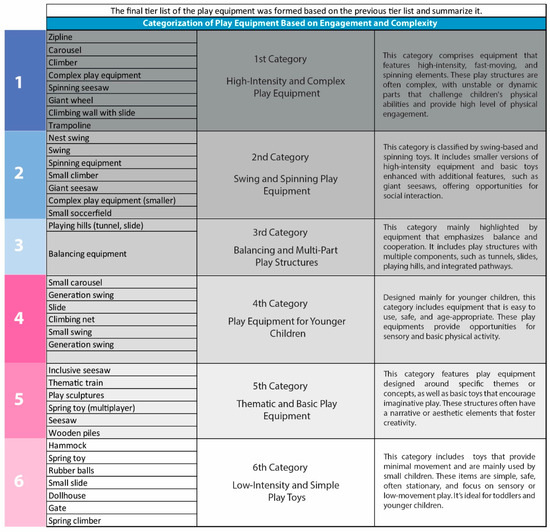
Figure 12.
Categorisation of play equipment based on engagement and complexity diagram.
The analysis of level of engagement was a complex process, which was determined together with the previously listed analyses. Level of engagement was determined by how interesting the play equipment was (value of interest), how varied movement it caused (number of movement frequency verbs), and how much time children spent on it; at the same time, the characteristics and needs of different age groups also played a role in which play equipment became more popular among children. The values of the analyses listed above were summarised, classified into different categories, and then represented as patterns for each playground, showing the age groups engaged next to them.
Numbers 1–6 were assigned to each piece of equipment, representing a ranking of popularity among children (6 represents the highest and 1 the lowest). This information can be valuable for playground designers and operators to understand which equipment is most favoured by children and to ensure a diverse range of play experiences are available.
Figure 13 organises the play equipment by the type of engagement they provide, the level of engagement and its hierarchy among all the other equipment, and the age groups they were mostly engaged by. This gives a clearer view of how each piece of equipment can be utilised based on these factors. Light blue represents the ages between 0–3 years old, pink (0–6 years old), dark blue (0–14 years old), green (3–6 years old), purple (3–14 years old), lastly, orange represents ages between 6–14 years old.

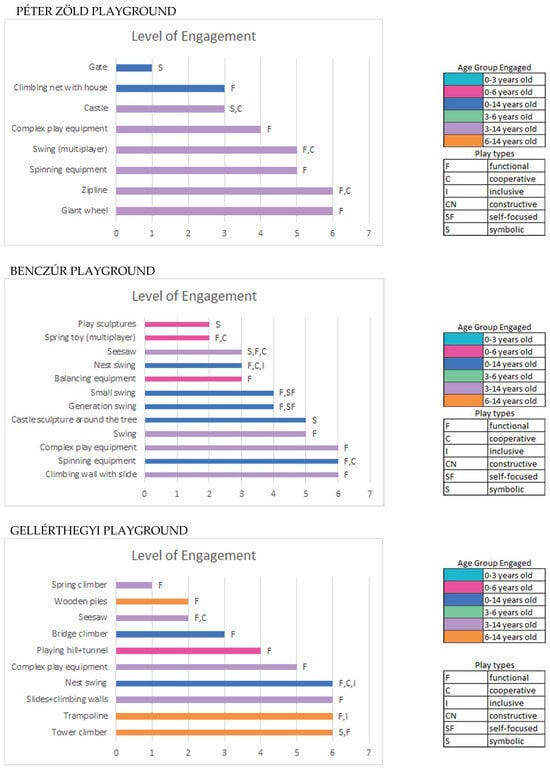
Figure 13.
Representation of the engagement/interaction analyses.
Linking Data to Sustainability: These findings aligned with the study’s sustainability goals. The longer use of high-tier equipment shows that it is worth investing in durable and flexible designs. Their physical and social benefits also contribute to healthier communities over time. For decision-makers, urban planners, and designers, focusing on these types of play structures—especially in low-income areas—can support more equitable access to stimulating play areas.
This study has made several innovative contributions to the existing literature on playground design and children’s play. First, it incorporated a holistic approach by integrating quantitative analyses of movement intensity, movement types, and time allocation with qualitative observations of play preferences and engagement levels with different play structures and equipment. This provided a more holistic understanding of children’s playground interactions in play spaces than previous studies that often focused on singular aspects. Second, the research categorised play equipment based on engagement levels, complexity, and age-specific usability, offering practical guidance for designers and planners. Third, it addressed the importance of designing sustainable playgrounds, emphasising the importance of resource efficiency, health promotion, and long-term engagement. Finally, the study’s examination of five diverse playground contexts in Budapest enhanced the transferability of the findings to various urban play settings.
6. Discussion
Children having access to nature in their everyday surroundings is associated with an overall healthy development (Mygind et al., 2021; ADELE research group, 2020; Söderström et al., 2013), and play with peers outdoors is the mode of interaction with nature deemed most important for their overall development (Tremblay et al., 2015; Wells and Lekies, 2006) [33]. The importance of promoting PA in childhood is confirmed by the fact that the PA level early in life seems to follow into adulthood (Pate, Baranowski, Dowda, & Trost, 1996; Telama et al., 2005) [34]. Today, children spend the majority of their leisure time engaged with electronic media. Given that electronic media are so stimulating, motivating children to engage in outdoor activities in playground settings may require that playgrounds be made more interesting by containing more varied play elements. Playgrounds also need to cater to the needs of caregivers who are necessary to bring and supervise the children in these settings [7].
Previous studies agree that specific types of equipment (e.g., water features and loose equipment) influence public and school playground use. In [35], the sculptures supported creative play but, by design, were focused on passive use (e.g., sitting and reading), as opposed to providing for a variety of physical activities, like hanging and sliding—they were “aesthetic but not functional”. Thus, the sculptures’ focus possibly explains the observed decline in “moderate-to-vigorous physical activity” in the study playground [35]. According to the findings in [16], among females, PA was highest on swings (82% (95% CI: 77, 86)) and lowest on paved areas (56% (95% CI: 43, 69)). Among males, it was highest on both swings (81% (95% CI: 75, 86)) and ball courts (83% (95% CI: 77, 89)) and lowest on grassy areas (64% (95% CI: 60, 67)). In the context of the article, PA was specifically examined during recess among children, highlighting its importance for health and development. Additionally, in [2], the results showed that playground size, mature trees, swings, climbers, and spinners were associated with longer stays, and stay time varied by group size, with larger groups staying longer. Previous research has shown that a certain way of shaping the playground space has an impact on the quality of play—its forms, socialisation, and duration—and, therefore, also on the physical and social development of the child [25]. As children are more likely to prefer playgrounds with an assortment of play equipment, playgrounds should provide a variety of play opportunities, both in terms of choice and challenge [27].
Innovative playgrounds attracted 2.5 times more users and generated almost 3 times as much moderate-to-vigorous physical activity [31]. As discussed in [16], swings, courts, and play structures were associated with a higher proportion of children being engaged in PA. Reference [33] highlighted that traditional play equipment significantly enhanced children’s emotional states, making them feel happier and more energetic compared to digital play settings. Although digital play is becoming increasingly common, the findings suggest it may not engage children as effectively as natural elements and traditional play equipment; thus, focusing on developing the engagement and the interaction between children and the play structure is a crucial aspect to maintain long-term interest, physical activity, and overall developmental benefits.
Outdoor play and physical activity have both been shown to enhance several aspects of child health, including physical fitness, motor development, cognition, and mental health outcomes [8].
Investigating play motions, behaviours, and levels of engagement provides valuable insights for further research into the dynamics and the patterns of play and their spatial use. By evaluating and analysing these patterns, we can identify key areas to focus on, enabling the implementation of engaging, inclusive, and dynamic play equipment. Such interventions allow for promoting higher levels of physical activity, thereby contributing to improved cognitive development and overall health benefits for children.
7. Conclusions
This study explored the interaction between playground equipment complexity and physical activity levels through an observational analysis of children’s play behaviour. The findings highlighted that complex and dynamic play structures, such as ziplines and carousels, significantly boosted children’s engagement, physical activity, and duration of use. These play structures not only promoted a wider range of physical movements but also sustained children’s interest for longer periods, as evidenced by the 27% of total observed activity attributed to such equipment. In contrast, static structures, while sometimes used, elicited less dynamic engagement.
The research drew attention to the importance of playground design in fostering physical activity, creativity, and social interaction among children. By analysing over 400 interactions, it became evident that design complexity, spatial density, and environmental factors play a critical role in shaping play behaviour and diverse activity patterns.
Our research aimed to highlight the importance of its contributions to further environmental sustainability. Below, we outline how these contributions make a meaningful impact for a long-term sustainable approach.
7.1. Efficient Use of Resources
By analysing the children’s behaviour and how they interact with different play structures, the study provided insights into which designs and equipment were most engaging and effective. This will help prioritise investments in durable and well-utilised play structures, reducing waste and ensuring long-term usability for the children.
7.2. Fostering Physical Activity, Health, and Well-Being
A sustainable play environment promotes health and well-being by encouraging physical activity and diverse movements, as discussed in the article. Supporting these behaviours and practices will ensure the long-term developmental benefits for children, aligning with social sustainability goals.
7.3. Longevity and Engagement
Playgrounds with complex and engaging designs that encourage diverse play activities are likely to be used more consistently over time, ensuring their value to the community and reducing the need for frequent redesigns or replacements.
Author Contributions
Conceptualization, L.A.; Methodology, L.A.; Software, L.H.; Formal analysis, L.H.; Investigation, L.A.; Resources, L.A.; Data curation, L.H.; Writing—original draft, L.A.; Writing—review & editing, L.A.; Visualization, L.H.; Supervision, A.E.; Project administration, A.E.; Funding acquisition, A.E.·All authors have read and agreed to the published version of the manuscript.
Funding
This research received funds from the Hungarian University of Agriculture and Life Science (MATE) for its publication.
Institutional Review Board Statement
Not applicable.
Informed Consent Statement
Not applicable.
Data Availability Statement
The original contributions presented in the study are included in the article, further inquiries can be directed to the corresponding authors.
Conflicts of Interest
The authors declare no conflict of interest.
References
- U.S. Department of Health and Human Services. Physical Activity Guidelines for Americans, 2nd ed.; U.S. Department of Health and Human Services: Washington, DC, USA, 2018.
- Cohen, D.A.; Talarowski, M.; Han, B.; Williamson, S.; Galfond, E.; Young, D.R.; Eng, S.; McKenzie, T.L. Playground Design: Contribution to Duration of Stay and Implications for Physical Activity. Int. J. Environ. Res. Public Health 2023, 20, 4661. [Google Scholar] [CrossRef] [PubMed]
- Lacharité-Lemieux, M.; Brunelle, J.-P.; Dionne, I.J. Adherence to Exercise and Affective Responses: Comparison between Outdoor and Indoor Training. Menopause 2015, 22, 731. [Google Scholar] [CrossRef]
- Pearce, M.; Saunders, D.H.; Allison, P.; Turner, A.P. Indoor and Outdoor Context-Specific Contributions to Early Adolescent Moderate to Vigorous Physical Activity as Measured by Combined Diary, Accelerometer, and GPS. J. Phys. Act. Health 2018, 15, 40–45. [Google Scholar] [CrossRef]
- Raustorp, A.; Pagels, P.; Boldemann, C.; Cosco, N.; Söderström, M.; Mårtensson, F. Accelerometer Measured Level of Physical Activity Indoors and Outdoors During Preschool Time in Sweden and the United States. J. Phys. Act. Health 2012, 9, 801–808. [Google Scholar] [CrossRef] [PubMed]
- Larson, L.R.; Hipp, J.A. Nature-Based Pathways to Health Promotion: The Value of Parks and Greenspace. N. Carol. Med. J. 2022, 83, 99–102. [Google Scholar] [CrossRef]
- Cohen, D.A.; Han, B.; Williamson, S.; Nagel, C.; McKenzie, T.L.; Evenson, K.R.; Harnik, P. Playground Features and Physical Activity in U.S. Neighborhood Parks. Prev. Med. 2020, 131, 105945. [Google Scholar] [CrossRef]
- James, M.E.; Jianopoulos, E.; Ross, T.; Buliung, R.; Arbour-Nicitopoulos, K.P. Children’s Usage of Inclusive Playgrounds: A Naturalistic Observation Study of Play. Int. J. Environ. Res. Public Health 2022, 19, 13648. [Google Scholar] [CrossRef]
- Qin, Q.; Nakamura, K.W.; Yamamoto, K.; Shimomura, A. A Study on Changes to the Form of Children’s Playgrounds in Japan by Analyzing the JILA Selected Works of Landscape Architecture. Sustainability 2019, 11, 2127. [Google Scholar] [CrossRef]
- Hulteen, R.M.; Morgan, P.J.; Barnett, L.M.; Stodden, D.F.; Lubans, D.R. Development of Foundational Movement Skills: A Conceptual Model for Physical Activity Across the Lifespan. Sports Med. 2018, 48, 1533–1540. [Google Scholar] [CrossRef]
- Pawlowski, C.S.; Madsen, C.D.; Toftager, M.; Amholt, T.T.; Schipperijn, J. The Role of Playgrounds in the Development of Children’s Fundamental Movement Skills: A Scoping Review. PLoS ONE 2023, 18, e0294296. [Google Scholar] [CrossRef]
- Broekhuizen, K.; Scholten, A.-M.; de Vries, S.I. The Value of (Pre)School Playgrounds for Children’s Physical Activity Level: A Systematic Review. Int. J. Behav. Nutr. Phys. Act. 2014, 11, 59. [Google Scholar] [CrossRef]
- Movahed, M.; Martial, L.; Poldma, T.; Slanik, M.; Shikako, K. Promoting Health through Accessible Public Playgrounds. Children 2023, 10, 1308. [Google Scholar] [CrossRef]
- Belčáková, I.; Galbavá, P.; Majorošová, M. Healing and Therapeutic Landscape Design—Examples and Experience of Medical Facilities. Archnet-IJAR Int. J. Archit. Res. 2018, 12, 128. [Google Scholar] [CrossRef]
- Ridgers, N.D.; Salmon, J.; Parrish, A.-M.; Stanley, R.M.; Okely, A.D. Physical Activity During School Recess: A Systematic Review. Am. J. Prev. Med. 2012, 43, 320–328. [Google Scholar] [CrossRef]
- Barenie, M.J.; Howie, E.K.; Weber, K.A.; Thakur, D.; Murphy, C.M.; Thomsen, M.R. Where the Children Play: Gender Gaps in Recess Physical Activity by Age and Playground Area. Prev. Med. Rep. 2024, 41, 102699. [Google Scholar] [CrossRef]
- Amholt, T.T.; Jespersen, J.F.; Zacho, M.; Timperio, A.; Schipperijn, J. Where Are Tweens Active in School Playgrounds? A Hot-Spot Analysis Using GPS, Accelerometer, and GIS Data. Landsc. Urban Plan. 2022, 227, 104546. [Google Scholar] [CrossRef]
- Park N Play and Design. How to Build a Sustainable Playground for Kids. Park N Play Design. Available online: https://www.parknplaydesign.com/post/how-to-build-a-sustainable-playground (accessed on 13 April 2024).
- Pfautsch, S.; Wujeska-Klause, A.; Walters, J. Outdoor Playgrounds and Climate Change: Importance of Surface Materials and Shade to Extend Play Time and Prevent Burn Injuries. Build. Environ. 2022, 223, 109500. [Google Scholar] [CrossRef]
- Storli, L.; Sandseter, E.B.H.; Lorås, H. Individual Differences in Children’s Movement Variability in a Virtual Reality Playground Task. Hum. Mov. Sci. 2024, 93, 103171. [Google Scholar] [CrossRef]
- Souter-Brown, G. Landscape and Urban Design for Health and Well-Being: Using Healing, Sensory and Therapeutic Gardens, 1st ed.; Routledge: London, UK, 2014; ISBN 978-1-315-76294-4. [Google Scholar]
- Eco-Friendly Playground Design. Available online: https://specialeducationalneedsanddisabilities.co.uk/eco-friendly-playground-design/ (accessed on 19 February 2024).
- The Practice of Biophilic Design. Available online: https://www.researchgate.net/publication/321959928_The_Practice_of_Biophilic_Design (accessed on 29 April 2025).
- Urlich, R.S. View Through a Window May Influence Recovery from Surgery. Science 1984, 224, 420–421. [Google Scholar]
- Czalczynska-Podolska, M. Therapeutic Playground: Typology of Solutions and Analysis of Selected Public Playgrounds as Places with Therapeutic Potential. Sustainability 2024, 16, 6414. [Google Scholar] [CrossRef]
- Sallis, J.F.; Floyd, M.F.; Rodríguez, D.A.; Saelens, B.E. Role of Built Environments in Physical Activity, Obesity, and Cardiovascular Disease. Circulation 2012, 125, 729–737. [Google Scholar] [CrossRef]
- Tait, K.; Liang, P.; Silveira, S. Why Can’t My Child Play Too? Current Challenges of Public Playgrounds for Children with Disabilities. Educ. Sci. 2024, 14, 1153. [Google Scholar] [CrossRef]
- Manóprogram. Zöld Péter Népmese Játszótér. Available online: https://manoprogram.hu/hova-menjunk/elemenybeszamolok/jatszoterek/209-zold-peter-nepmese-jatszoter (accessed on 18 December 2024).
- No, W.; Choi, J.; Kim, Y. How Do Children Move and Behave on Streets? Vision-Based Movement Behavior Analysis Using Children’s Trajectories in Urban Surveillance Systems. Appl. Geogr. 2024, 162, 103170. [Google Scholar] [CrossRef]
- Squires, K.; van Rhijn, T.; Breau, B.; Harwood, D.; Haines, J.; Coghill, M. A Quasi-Experimental Investigation of Young Children’s Activity Levels and Movements in Equipment-Based and Naturalized Outdoor Play Environments. J. Environ. Psychol. 2024, 97, 102364. [Google Scholar] [CrossRef]
- Cohen, D.A.; Talarowski, M.R.; Han, B.; Williamson, S.L.; Galfond, E.C.; Young, D.R.; Eng, S.; McKenzie, T.L. Playground Design and Physical Activity. Am. J. Prev. Med. 2023, 64, 326–333. [Google Scholar] [CrossRef]
- Makalesi, A.; Amirshoev, S.A.; Güneş, S.; Oyun, M.; Tasarımları, A.; Temel, Ç.; Becerileri, H.; İncelenmesi, A.İ.; Kelimeler, A.; Gelişimi, Ç.; et al. Examination of the Relationship between Existing Playground Designs and Children’s Fundamental Movement Skills. Eur. J. Sci. Technol. 2023, 49, 25–33. [Google Scholar]
- Sallnäs Pysander, E.-L.; Mårtensson, F.; Waern, A.; Litsmark, A.; Hedblom, M.; Raustorp, A.; Ghilagaber, G.; Zhu, H. Nature and Digitalization Challenging the Traditional Playground. Urban For. Urban Green. 2024, 93, 128148. [Google Scholar] [CrossRef]
- Andersen, H.B.; Klinker, C.D.; Toftager, M.; Pawlowski, C.S.; Schipperijn, J. Objectively Measured Differences in Physical Activity in Five Types of Schoolyard Area. Landsc. Urban Plan. 2015, 134, 83–92. [Google Scholar] [CrossRef]
- Bohn-Goldbaum, E.E.; Phongsavan, P.; Merom, D.; Rogers, K.; Kamalesh, V.; Bauman, A.E. Does Playground Improvement Increase Physical Activity among Children? A Quasi-Experimental Study of a Natural Experiment. J. Environ. Public Health 2013, 2013, 109841. [Google Scholar] [CrossRef]
Disclaimer/Publisher’s Note: The statements, opinions and data contained in all publications are solely those of the individual author(s) and contributor(s) and not of MDPI and/or the editor(s). MDPI and/or the editor(s) disclaim responsibility for any injury to people or property resulting from any ideas, methods, instructions or products referred to in the content. |
© 2025 by the authors. Licensee MDPI, Basel, Switzerland. This article is an open access article distributed under the terms and conditions of the Creative Commons Attribution (CC BY) license (https://creativecommons.org/licenses/by/4.0/).